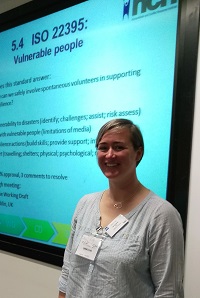Can you briefly describe the project and what you are trying to achieve?
The proposed standard provides guidance on how to address the needs of vulnerable people not only immediately after a disaster, but also how to address long-term response and how to develop a plan to support vulnerable people in the event of an emergency. This project was based in part on over 10 months of my post-disaster fieldwork in Nicaragua in the immediate aftermath of Hurricane Felix in 2007. Additionally we have drawn from research conducted in Lincolnshire, supported by a UK government department called DEFRA1 .
While it is hard to translate and generalize research, we have identified a number of principles which can be standardized and communicated to a very broad audience. I feel strongly about these issues and this standards project helps to bring together my research and other best practices to provide practical and innovative solutions to real global challenges.
What expertise and input are you looking for to develop the standard?
Moving the committee draft to a DIS will allow us to get valuable feedback from a wider group of stakeholders to make the standard more globally relevant. In the aftermath of recent emergencies such as: hurricanes, floods, wild fires, ice storms and mass migration of refugees, organizations have developed best practices in supporting the needs of our most vulnerable citizens. We would like to hear from countries who have experience working with vulnerable people during emergencies.
What are the key challenges in developing ISO 22395?
There are challenges in developing common definitions for vulnerable people in emergencies. These can differ from a legal and a political perspective. We need to find the right balance in the standard between the guiding principles and the amount of practical guidance required for users in different countries.
How did you get involved in TC 292 work?
My academic background covers biological sciences, environmental resource management, human geography and international development. At the end of my research in Nicaragua and Swaziland, I had the opportunity to work with Duncan Shaw, the convenor of WG 5 and members of BSI, to explore how my research could have a greater impact through a standardization project. I think there is great potential to bring research and standardization closer together. You are transcending different worlds.
How can ISO get more young professionals involved in standards?
Research can help to identify and shape innovative fields which can benefit from standardization projects. However, standards work requires a significant commitment for many young academics and it can be hard to identify the resources required to get involved in standards work. I believe that standards developers need to sell the impact of standards work and the value of networking opportunities to younger academics. Standards work allows me to build relationships with other experts over time, to explore new ideas and to combine this work with my ongoing research.
1 Shaw D, Scully J and Hart T (2011) The response of vulnerable people to coastal inundation in Lincolnshire: A needs and actions analysis. Lincolnshire County Council. 26th January. ISBN 467 978-1-85449-402-3
Interview made by Jeanne Bank, Canada